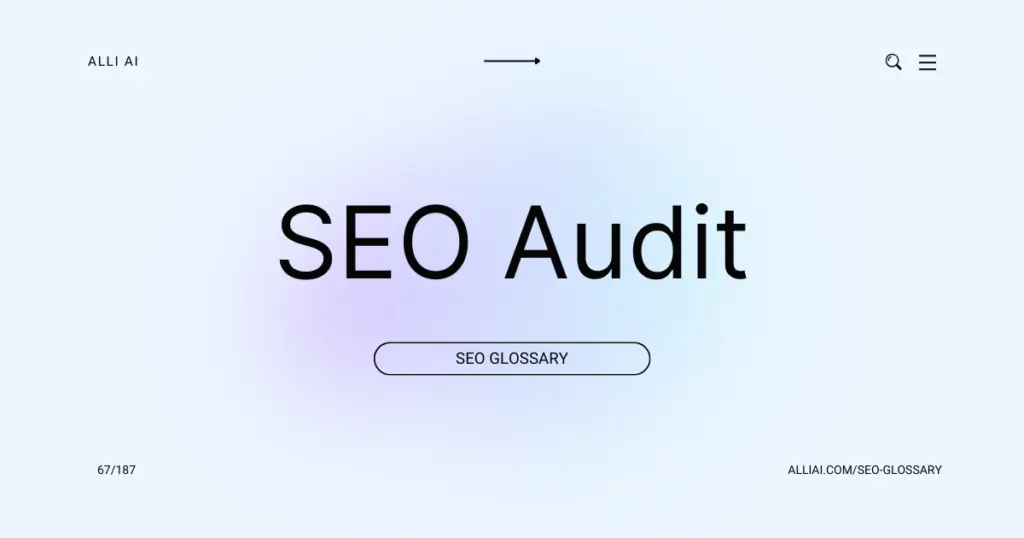What Does SEO Audit Mean?
An SEO audit is a process where you check a website’s health in terms of its visibility and ranking on search engines. It involves scrutinizing the website to find areas of improvement and understand how to boost its performance in search results. This allows you to spot problems like broken links or outdated keywords, and helps ensure the site is optimized to attract and engage visitors.
Where Does SEO Audit Fit Into The Broader SEO Landscape?
An SEO audit is a comprehensive analysis of a website’s visibility, typically conducted to identify the strengths and weaknesses of its search engine optimization. It fits into the broader SEO landscape as a crucial diagnostic tool that helps understand how well a website complies with best practices. The audit is the first step in creating an actionable plan to improve performance, enhance competitiveness in search engine rankings, and identify issues related to website structure, content, and outreach that may be impeding it from achieving optimal performance.
Regular SEO audits ensure that a website is aligned with the rapid evolutions of search engine algorithms. They allow SEO strategists to refine their approaches, correct deficits, and capitalize on emerging opportunities. Thus, audits are foundational to maintaining and improving SEO strategy, directly impacting areas such as on-page optimization, technical SEO, and off-page SEO. This methodical approach facilitates setting priorities, allocating resources effectively, and ultimately improving the site’s ranking and visibility.
Real Life Analogies or Metaphors to Explain SEO Audit
1. SEO Audit as a Doctor’s Check-up
Imagine your website is a person, and the SEO audit is like going to the doctor for a full health check-up. Just as a doctor examines different health markers to ensure you are in good health, an SEO audit checks various site elements to ensure your website is healthy and performing well in search engines.
2. SEO Audit as a Car Inspection
Think of an SEO audit like taking your car for a service inspection. You check the engine, brakes, and tires to make sure everything is working as it should, to avoid breakdowns. Similarly, an SEO audit examines components like site speed, security, and content quality to keep your website running smoothly, attracting traffic and avoiding penalties.
3. SEO Audit as a Home Energy Audit
A home energy audit assesses how much energy your home consumes, and helps you understand how you can make your home more energy efficient. Likewise, an SEO audit evaluates your website to see how efficiently it attracts and engages visitors, and offers insights on how to optimize its performance.
4. Gardening and Pruning (SEO Audit)
Envision a gardener tending a garden, where regular pruning helps plants grow better and healthier. An SEO audit acts similarly for your website, trimming away outdated or ineffective practices and nurturing the areas that enhance visibility and growth in organic search results.
5. Map Review Before a Road Trip (SEO Audit)
Before you head out on a long road trip, you review a map to plan the best route and identify possible roadblocks. An SEO audit reviews your website’s navigation and structure, ensuring there are no blockages in user experience and information flow that could deter visitors from reaching their destination on your site.
How the SEO Audit Functions or is Implemented?
1. Crawling and Indexing:
– Use tools like Google Search Console, Screaming Frog, or Ahrefs to analyze how search engines crawl and index the site.
2. Technical SEO:
– Check for HTTPS status codes.
– Identify crawl errors.
– Review and optimize robots.txt.
– Test and improve site speed and mobile-friendliness.
– Ensure proper use of canonical tags.
– Analyze and enhance XML sitemaps.
3. On-Page SEO:
– Audit meta tags (titles and descriptions).
– Check heading tags for proper structure.
– Evaluate content quality and keyword optimization.
– Check for duplicate content issues.
– Verify internal linking structure.
– Examine image alt text usage.
4. Off-Page SEO:
– Analyze backlinks (number, quality, and relevancy).
– Check for any potential penalties or toxic links.
– Evaluate the strength of social media presence.
5. Website User Experience:
– Analyze user engagement metrics (bounce rate, time on site, pages per session).
– Check for intuitive navigation and user interface.
– Ensure conversion points are strategically placed and functioning.
6. Competitor Analysis:
– Identify SEO strategies utilized by competitors.
– Compare domain authority, backlinks, content strategy, and keyword rankings.
– Look for gaps in their strategy that can be capitalized on.
7. SEO Tools and Analytics:
– Implement and verify proper tracking with tools like Google Analytics.
– Set up and monitor SEO dashboard for ongoing performance.
8. Performance Reporting and Recommendations:
– Generate SEO audit reports detailing current status and issues.
– Prioritize issues based on impact and difficulty of implementation.
– Develop an actionable plan to address identified SEO issues and opportunities.
Impact SEO Audit has on SEO
An SEO audit evaluates a website comprehensively to identify issues and opportunities related to its search engine performance. It impacts a website’s SEO performance, rankings, and user experience in several ways:
1. Identifying Technical SEO Issues: An audit can uncover technical issues such as broken links, slow page loading speeds, and improper use of canonical tags, which can hinder a site’s ability to be effectively crawled and indexed by search engines.
2. On-Page SEO Enhancements: It checks for on-page elements such as keyword optimization, meta descriptions, headers, and image alt attributes to ensure they are effectively optimized to rank for relevant queries.
3. Content Strategy Improvements: Audits can reveal gaps in content or issues with quality and relevancy. Enhancing content based on audit findings can boost keyword rankings and meet user intent more effectively.
4. User Experience Optimization: The audit process assesses the usability of the site, including mobile responsiveness, navigation, and interface design, which are essential factors for ranking and can influence user engagement and conversion rates.
5. Link Profile Analysis: Evaluating the site’s link profile during an audit highlights toxic or poor-quality backlinks that might be penalizing the site and identifies opportunities for building high-quality links.
6. Compliance with Best Practices: SEO audits ensure that a website is up-to-date with the latest search engine guidelines and best practices, which can protect against penalties and devaluations in search rankings.
7. Strategic Insight into Competitors: Audits often include a competitive analysis that can unveil competitors’ strengths and weaknesses, offering strategic insights that can be leveraged to refine SEO strategies and improve rankings.
8. Structural and Architectural Advice: The audit analyzes the website’s structure and architecture, recommending changes that can facilitate better indexing and user navigation.
By addressing these areas, an SEO audit directly enhances a website’s visibility, user experience, and ultimately, its positioning in search engine results pages (SERPs).
SEO Best Practices For SEO Audit
1. Crawl the Website: Use tools like SEMrush, Ahrefs, or Screaming Frog to identify crawl errors, broken links, and other technical issues.
2. Check HTTPS Status Codes: Ensure that all URLs redirect to their HTTPS version and return the correct 200 status code.
3. Optimize Site Speed: Use Google PageSpeed Insights to identify and fix issues slowing down your site.
4. Enhance Mobile Usability: Check the site’s mobile usability with Google’s Mobile-Friendly Test and address any issues.
5. Secure the Website: Ensure the website has a valid SSL certificate and is accessible via HTTPS only.
6. Implement Schema Markup: Use Google’s Structured Data Testing Tool to check existing schema markup and add new markup where necessary.
7. Optimize On-Page Elements: Update title tags, meta descriptions, headers, and images (alt text) for targeted keywords.
8. Check Internal & External Links: Review and optimize internal linking structure and remove or disavow toxic external links.
9. Improve Content Quality: Analyze content for quality and relevance, updating or removing outdated content.
10. Create XML Sitemap & Robots.txt: Ensure the XML sitemap is updated and submitted to search engines. Validate and optimize the Robots.txt file.
11. Fix Duplicate Content: Use tools like Copyscape or Siteliner to find and correct duplicate content issues.
12. Monitor Backlinks: Use Ahrefs or SEMrush to analyze and improve the link profile.
13. Implement and Verify Google Analytics & Google Search Console: Ensure both tools are set up correctly and gathering data.
14. Conduct Keyword Research: Identify target keywords for each page and include them in various on-page elements.
15. Local SEO Optimization: Update Google My Business and other local listings, ensure NAP consistency across directories.
16. Improve User Engagement: Optimize page elements to enhance user engagement and user retention metrics.
17. Regular Reporting and Adjustment: Generate monthly SEO reports to monitor progress and adjust strategies accordingly.
Common Mistakes To Avoid
1. Overlooking Mobile Optimization:
– Regularly test mobile usability.
– Ensure website design is responsive.
2. Ignoring Local SEO:
– Optimize for local search terms and regional keywords.
– Maintain updated and accurate local business listings.
3. Using Outdated SEO Practices:
– Stay informed on the latest algorithms and SEO trends.
– Abandon keyword stuffing, hidden texts, and other deprecated techniques.
4. Skipping Technical SEO:
– Conduct thorough checks for crawl issues, broken links, and site speed.
– Implement structured data markup and XML sitemaps as needed.
5. Neglecting Content Quality:
– Focus on creating valuable, unique, and engaging content.
– Regularly update and refresh old content to maintain relevance and accuracy.
6. Failing to consider User Experience (UX):
– Monitor site navigation and user engagement metrics.
– Enhance the overall aesthetic, readability, and navigation ease.
7. Not Using Analytics to Drive SEO Strategy:
– Utilize tools like Google Analytics to track user behavior and conversion rates.
– Adjust SEO strategies based on data-driven insights.
8. Inadequate Keyword Research:
– Invest time in understanding market trends and user intent.
– Use advanced tools for thorough keyword analysis and competitor insights.
9. Neglecting Social Media Signals:
– Integrate social media strategies with SEO efforts.
– Encourage content sharing and interaction across social platforms.
10. Overlooking Website Security:
– Ensure all pages are secured with HTTPS.
– Regularly update software and plugins to avoid vulnerabilities.
11. Incomplete Competitor Analysis:
– Regularly review competitor strategies and market positioning.
– Adapt strategies based on market and competitor insights.
12. Underestimating the importance of backlinks:
– Focus on building high-quality and relevant backlinks.
– Regularly audit backlink profile to remove or disavow harmful links.






